From the Williams-Sonoma early Summer 2014 catalogue.
Tips from Amy Wilson principal designer at The Organic Gardener on how to make the most of a rooftop.
View also: 7 Expert Tips for Rooftop Gardening
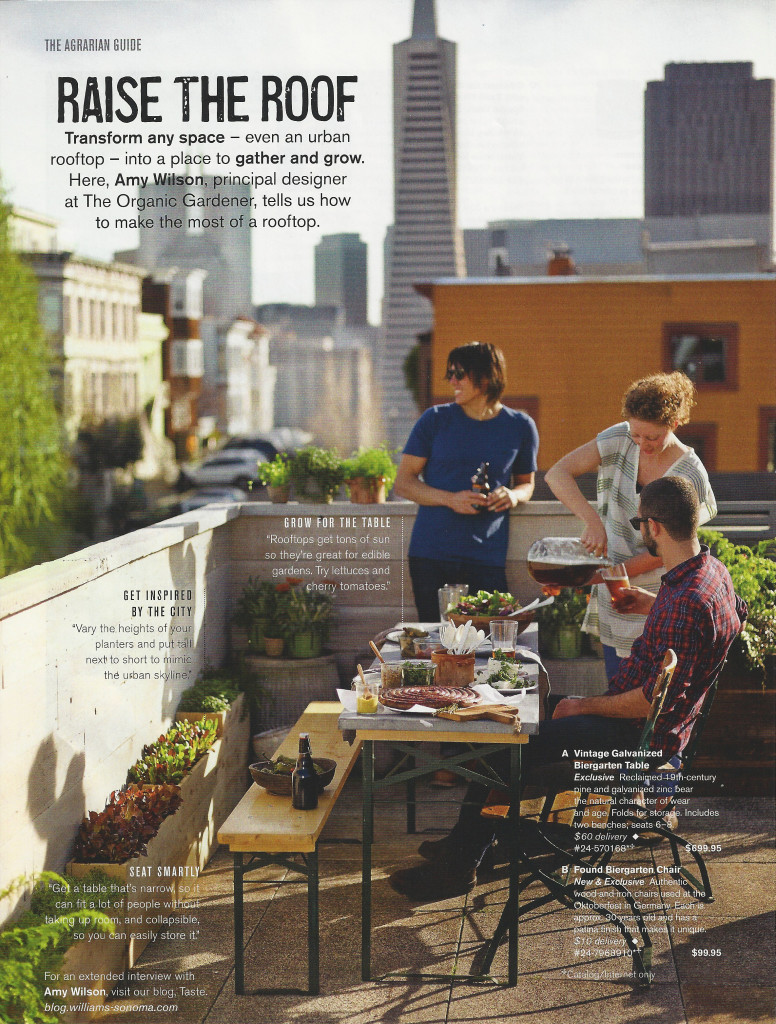
From the Blog
From the Williams-Sonoma early Summer 2014 catalogue.
Tips from Amy Wilson principal designer at The Organic Gardener on how to make the most of a rooftop.
View also: 7 Expert Tips for Rooftop Gardening

by CHRISSY RUTHERFORD, Harper’s Bazaar, May 9, 2014
There’s nothing like hitting a rooftop bar on a warm summer evening for post-work cocktails. We’ve rounded up 4 of the new and newly revamped rooftops to take in the view this season.
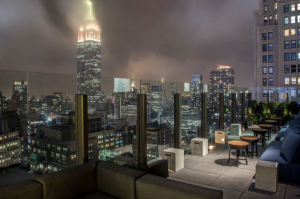
Photo: The Skylark
Source: www.harpersbazaar.com
1) The Skylark
For midtown revelers, enjoy your libations with a gorgeous view of the Empire State building and downtown Manhattan.
2) The Roof, Viceroy New York
This upscale rooftop bar has a picturesque view of Central Park, the perfect setting for a sunset Instagram. Look out for cool DJs providing the soundtrack for your Friday and Saturday nights.
3) Top of the Standard, High Line
While this rooftop isn’t new it did just get a serious makeover during the Fall of 2013—so this year if you’re lucky enough to make it to the top, you’ll enjoy the Havana-nights decor, as well as the resident chef Soa Davies’s fine Japanese BBQ from Robataya Grill.
4) The Jane Hotel
Maybe the most exclusive rooftop to hit for a drink this summer— the Jane’s rooftop is finally open to the public, but by appointment only.
by MADELEINE LIST, The Diamondback, February 20, 2013

Photo: Diana Daisey
Source: www.diamondbackonline.com
Most students have to rely on the dining halls or fast food options for food, but some will soon learn how to grow their own.
All it takes are the right tools and techniques and a little bit of guidance. And that’s where Melissa Avery steps in.
Last Tuesday, nearly 20 students gathered at the Apiary for the first in a series of winter workshops about gardening. The Arboretum and Botanical Garden and a collaboration of the university’s Community Gardens hosted the workshop, called Gardening 101. Avery, master gardener in training, instructed attendees on the basics of gardening, and answered questions from students about how to raise their own plants.
Because winter isn’t the season for planting, people interested in gardening have a few weeks before spring to learn the basics, said Yixin Chen, communications manager for the public health garden and sophomore nutritional science major.
“It’s a great way for people who are interested in gardening to realize, ‘Oh yeah, I can do this.’ Having that knowledge is a big first step,” she said.
Georgia Handforth, a co-manager at the Rooftop Community Garden and a senior communications and sociology major, said it’s beneficial for students to learn how to grow their own plants on the campus.
par Romane Energie/Mediacom, 5 novembre 2013
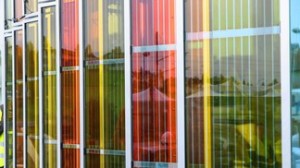
Façade composée de cellules solaires à colorant
Photo: École polytechnique fédérale de Lausanne / Alain Herzog
Source: http://actu.epfl.ch
Des panneaux photovoltaïques translucides et colorés, fruits de la technologie Graetzel, sont actuellement en cours d’installation sur la façade ouest du futur SwissTech Convention Center de l’EPFL, qui ouvrira ses portes en avril 2014. Ces 1’400 modules solaires de 35 x 50 cm formeront bientôt une surface totale de 300 m2. Ils sont déclinés en 5 tonalités différentes de rouge, vert et orangé, selon un design des artistes Daniel Schlaepfer et Catherine Bolle, qui confère à l’ensemble une esthétique chaleureuse et dynamique.
Ce vitrage solaire appliqué en façade extérieure est une première mondiale. Le projet tire parti du potentiel des cellules de Graetzel, ou cellules solaires à colorant : translucides, elles sont également indifférentes à l’angle d’incidence de la lumière, et peuvent être déployées verticalement sans aucune perte de rendement. En plus de produire de l’électricité d’origine renouvelable, elles protègent le bâtiment de l’ensoleillement direct, et réduisent ainsi le recours à une énergie de refroidissement. Cette installation solaire innovante est intégralement financée par Romande Energie. Elle sera mise en service en décembre prochain.
par Enerzine, 3 décembre 2013
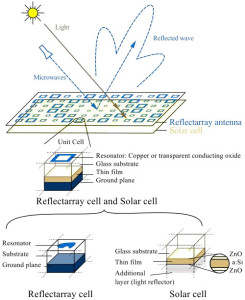
Une surface mixte, qui permet de préserver d’excellentes performances tant pour l’antenne que pour la cellule photovoltaïque
Image: École polytechnique fédérale de Lausanne
Source: www.enerzine.com
Traditionnellement, antennes de télécommunication et cellules solaires ne font pas bon ménage. Elles doivent fonctionner indépendamment pour ne pas interférer. Cette contrainte a par exemple des répercussions sur le poids et la taille des satellites: ils doivent disposer d’une surface assez grande pour accueillir à la fois un système d’antennes – pour émettre et capter des données -, et à la fois des panneaux solaires, pour l’alimentation en électricité.
Dans le cadre de son projet de master effectué au sein du groupe Perruisseau-Carrier, Philippe Dreyer propose de fusionner cellules solaires et antennes. En collaboration avec le groupe Transparent Conductive Oxides (TCOs) du Laboratoire de photovoltaïque (PV-LAB), il a mis au point une surface mixte, qui permet de préserver d’excellentes performances tant pour l’antenne que pour la cellule photovoltaïque.
De quoi réduire substantiellement le volume, le poids et le coût des satellites. Mais pas seulement. Les stations de communication portatives et autonomes, qui sont souvent utilisées pour établir des contacts lors de catastrophes naturelles, pourraient en bénéficier. Dotée de cette nouvelle technologie, elles pourraient devenir plus légères et donc se déplacer plus aisément. «Notre approche est aussi compatible avec des implémentations flexibles. Il serait donc concevable de plier notre dispositif, afin qu’il ne se déploie qu’une fois arrivé dans les lieux sinistrés», illustre le professeur Perruisseau-Carrier, qui a supervisé le projet.
by KAID BENFIED, Switchboard, Natural Resources Defense Council staff blog, April 25, 2012
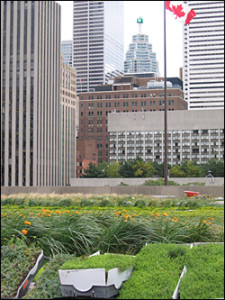
City Hall Podium
Source: www1.toronto.ca
In January of 2010, Toronto became the first city in North America to require the installation of green roofs on new commercial, institutional, and multifamily residential developments across the city. Next week, the requirement will expand to apply to new industrial development as well.
Simply put, a “green roof” is a rooftop that is vegetated. Green roofs produce multiple environmental benefits by reducing the urban heat island effect and associated energy demand, absorbing rainwater before it becomes runoff, improving air quality, and bringing nature and natural diversity into urban environments. In many cases, green roofs can also be enjoyed by the public much as a park can be.
Toronto’s requirements are embodied in a municipal bylaw that includes standards for when a green roof is required and what elements are required in the design. Generally speaking, smaller residential and commercial buildings (such as apartment buildings less than six stories tall) are exempt; from there, the larger the building, the larger the vegetated portion of the roof must be. For the largest buildings, 60 percent of available space on the roof must be vegetated.
For industrial buildings, the requirements are not as demanding. The bylaw will require that 10 percent of available roof space on new industrial buildings be covered, unless the building uses “cool roofing materials” for 100 percent of available roof space and has stormwater retention measures sufficient to capture 50 percent of annual rainfall (or the first five mm from each rainfall) on site. For all buildings, variances to compliance (for example, covering a lesser roof area with vegetation) may be requested if accompanied by fees (keyed to building size) that are invested in incentives for green roof development among existing building owners. Variances must be granted by the City Council.
Copyright © 2024 · Minimum Theme on Genesis Framework · WordPress · Log in